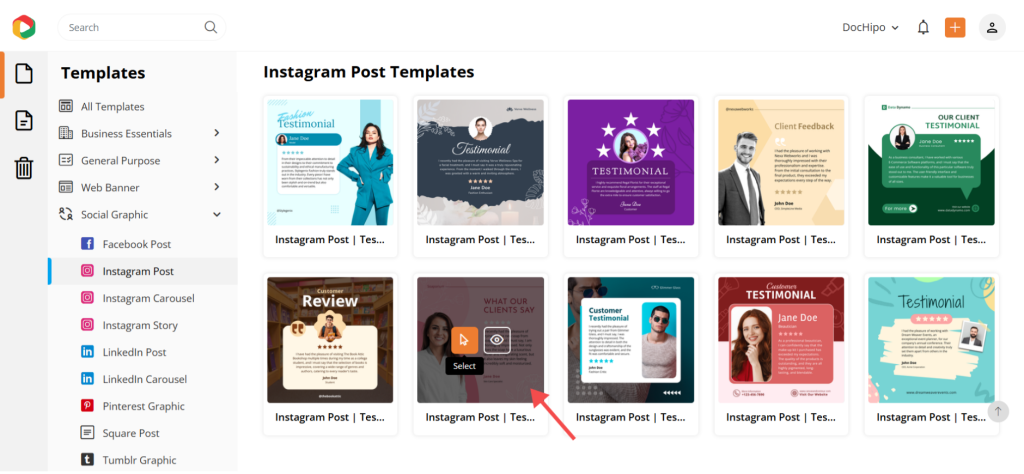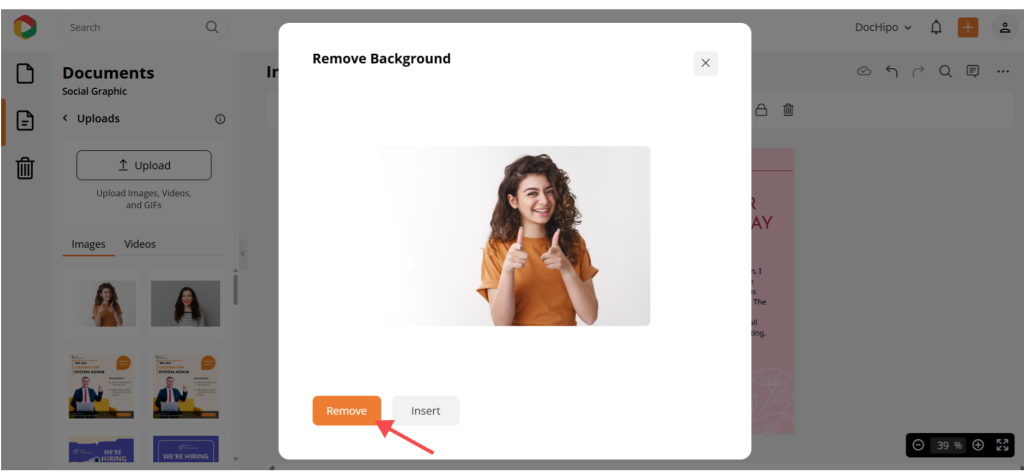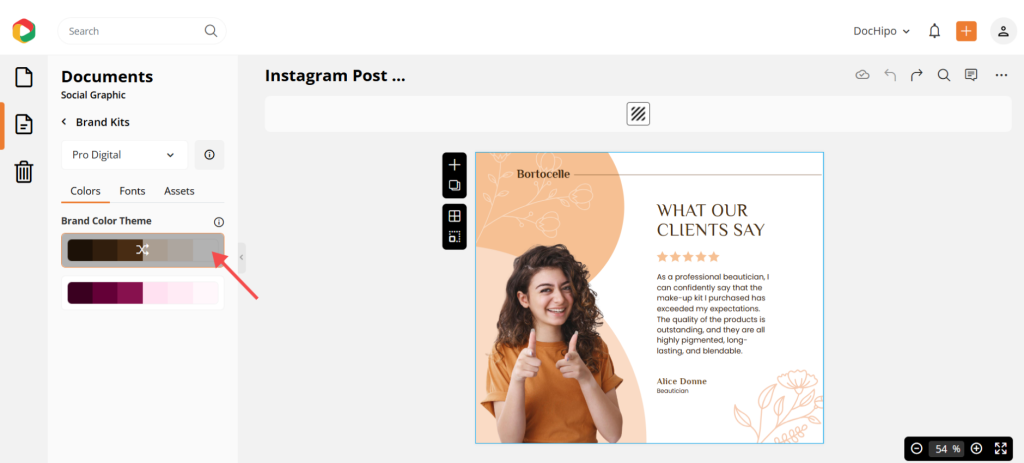
How to Create Testimonials that Win Trust: A Step-by-Step Guide

Do you want to establish your social proof and promote your brand across various social media platforms? Customer testimonials are the best way to market without making it all about bragging about yourself. However, testimonials should not be a large block of text, as viewers will likely scroll through it instantly. So, how to create testimonials that actually work?
How to Create Testimonials
- Gather Authentic Customer Testimonials: Select clients who have had a recent positive experience and send them mail or automated forms to collect feedback.
- Pick the Most Impactful Quotes: Pick the best lines focusing on stories of transformation that highlight real results.
- Choose the Best Platform and Format: Match the format and platform to your audience’s habits and attention span for maximum impact.
- Plan the Text and Visual Layout: Use high-quality visuals, legible fonts, and strong contrast. Limit to three colors and leave ample white space.
- Add Branding Elements: Add your logo, brand colors, tone, and fonts to the testimonial layout.
- Review and Get Permission: Carefully review the text content, names, photos, and visual elements, and obtain the customer’s written or recorded consent.
- Publish the Testimonial: Ensure that you follow all the standard specifications before publishing. Use relevant captions, hashtags, and a CTA.
In this blog, you will learn everything about how to create a good testimonial from scratch. We have covered the benefits, length, and testimonial graphic design. You can also find suitable template examples to design for different platforms.
Table of Contents
What are Testimonials
In the literal sense, a testimonial is an expression of appreciation for the ability, character, or quality of a person, product, or service. However, we are discussing testimonials for brands or businesses in this context. You can receive positive words from your customers, colleagues, or employers that help you establish authenticity.
Another thing to note is the distinction between a testimonial and a review. To put it simply, testimonials serve as endorsements that businesses use to present themselves in a positive light. In contrast, reviews focus on the customer’s perspective and experience, which can be positive or negative.
Here is a testimonial for DocHipo on the website, highlighting its ease of use.

Why are Customer Testimonials Important
Simply bragging about your product or service won’t influence people, but testimonials would. If you are still wondering why to share customer testimonials on social media or a website, you must know that positive testimonials on sales pages increase sales by 34%.
That’s not all. Here are a few more reasons why testimonials are good for business:
Testimonials Establish Trust and Reliability
As a customer, you can find everything about a product or a service. But when it comes to experience, 9 out of 10 people trust what a customer says. When real customers share their positive experiences, it instantly makes your business appear more reliable and authentic.
Customer Testimonials Help Validate Claims
Testimonials are among the most reliable indicators of a brand’s credibility. Instead of generic marketing claims, testimonials show specific, real-world results. They serve as a litmus test for authenticity, revealing whether a brand truly delivers on its promises.
Testimonials Enhance Your Marketing Content
Testimonial social media posts are excellent marketing tools that help persuade your audience. In fact, customer testimonials have the highest content marketing effectiveness rating of 89%. Additionally, they help bring variety to your social media page. You can repurpose testimonials across your website, social media, emails, or ads.
For inspiration, take a look at this clean and professional design from DocHipo’s Business LinkedIn Post Templates.

Get This Template and More
Testimonials Establish a Human Connection
Real stories from satisfied customers create an emotional connection that plain marketing can’t achieve. They give your business a relatable voice. If done correctly, testimonials can play a crucial role in emotional marketing.
Client Testimonials Help Build a Positive Reputation
Client testimonials play a key role in shaping a positive reputation. When happy customers share their genuine experiences, it shows that your brand consistently delivers value and satisfaction. Over time, these stories build a strong sense of trust and credibility, thus turning satisfied clients into your most persuasive brand advocates.
What Should a Testimonial Include
There are a few key elements that you should include in your testimonial to maximize its impact. It’s not necessary to incorporate all of these, but these elements keep your testimonial focused and concise:
- The Problem: Describe the central challenge or issue your customer faced before using your product.
- The Solution: Share how the product or company helped resolve their problem.
- The Results: Be specific and mention measurable results or clear improvements wherever possible.
- Customer Information: Add the full name and photo of your client to make your testimonial trustworthy.
- Authentic Quotes or Lines: Avoid over-the-top praise and focus on honest, personal details that you can quote.
- Legible and Readable Text: Keep your testimonial focused and easy to read.
How Long Should a Testimonial Be
Your clients can write or speak highly of your brand, but that doesn’t mean you need to post long paragraphs of testimonials. People instantly lose interest as soon as they see a block of text. That’s why you need to know what the ideal length of your testimonial is.
Written Testimonials
When your clients or customers send reviews, you need to review them and select the most essential aspects that highlight specific features. Here is what you can aim for:
- Two to three sentences: Avoid writing in long sentences and focus on precise details.
- Target 50-150 words: Use words carefully that reflect an unbiased review of your business.
For example, here is what a testimonial with balanced text content looks like.

Get This Template and More
Video Testimonials
88% of marketing teams report a 10%+ increase in conversions in campaigns featuring testimonial videos. If you can get video testimonials, they act as excellent social proof. Consider the following points to determine the optimal length for your video testimonials.
- Keep it short: Videos under a minute are more likely to hold attention and be watched till the end, especially on social media.
- Go for 1- 2 minutes: This duration works best for in-depth stories or testimonials on your website or landing pages.
- Hook them early: Begin with a strong opening that instantly captures interest and keeps viewers engaged.
How to Create Testimonials: Step-by-Step
Now, we come to the central part, which is how to create testimonials from scratch. So, let’s explore every step.

Step 1: Gather Authentic Customer Testimonials
The first thing that comes to mind when it comes to collecting testimonials is how to ask for a testimonial from a client. To do this, you need to identify the right client and opportunities.
First, choose clients who recently had a positive experience with your product or service, completed a project together, or have expressed satisfaction.
Next, establish a rapport with the customer and build a relationship so that they are willing to assist you. It provides you with an opportunity to solicit their feedback. Once they agree, you can send them mail, a questionnaire, or automated forms for a structured approach.
Offer different format options, such as written or video formats, or any other platform, to allow them to send their feedback.
Step 2: Pick the Most Impactful Quotes
Once you have received the review from your clients, it’s time to pick the best lines and frame your testimonial. Focus on stories of transformation that highlight real results. Keep them clear, concise, and authentic, editing only for grammar or length without altering the customer’s intent.
Also, prioritize quality over quantity by choosing testimonials with specific, genuine details. Always lead with the most powerful statement to grab attention and clearly show the value your product or service delivers.
To illustrate, here is an example from Testimonial Instagram Post Templates. You can notice how the opening lines give a clear idea about the service and what impressed the customer the most.

Get This Template and More
Step 3: Choose the Best Platform and Format
Choosing the best platform depends on where your target audience spends their time. The key is to match the format and platform to your audience’s habits and attention span for maximum impact. You can use a mix of formats, such as written quotes, video testimonials, or case studies, to add variety and credibility.
Step 4: Plan the Text and Visual Layout
When creating impactful testimonials, one of the significant questions is how to layout a testimonial. To make your testimonial look good, adopt a visual-first approach and maintain a balance between text and graphics. You can follow a structure including the testimonial quote, name, role, and brand elements.
Enhance its appeal with high-quality visuals and clean design aesthetics to minimize distractions. Select a legible font and one with strong contrast for optimal readability. Additionally, limit your design to up to three colors and leave ample white space to make it more visually appealing.
Here is an organized layout with balanced text and on-theme visual elements from DocHipo’s Testimonial Facebook Post Templates that requires minimal changes.

Get This Template and More
Step 5: Add Branding Elements
To strengthen brand recall, add your logo, brand colors, tone, and fonts to the testimonial layout. You can also add subtle visual cues, such as color accents or background patterns, to blend seamlessly with your overall design. It makes your testimonials look professional, credible, and instantly recognizable.
For instance, observe the use of iconic brand colors and fonts from Testimonial WhatsApp Story Templates, which make testimonial graphics stand out.

Get This Template and More
Step 6: Review and Get Permission
Once you are ready with the layout, review the testimonial and send it to the concerned client for permission. Carefully review the text content, names, photos, and visual elements to ensure they align with your brand. It’s better to obtain the customer’s written or recorded consent to use their words, name, and photo in your marketing materials.
Step 7: Publish the Testimonial
While publishing the testimonial, ensure that you follow all the standard specifications. In addition, use clear and compelling captions for your posts, like ‘what our clients say’. Further, you can add relevant hashtags and a CTA option in any testimonial social media post. Schedule your post at your audience’s most active hours and plan the frequency of posts strategically.
Here is an eye-catching layout from Testimonial Instagram Story Templates with a CTA.

Get This Template and More
How to Design a Testimonial with DocHipo
After tracing every step of how to create testimonials, let’s explore how you can design one within minutes. To achieve this, you can opt for DocHipo as your design tool, as it provides ready-to-use client testimonials templates with a professional layout.
Before you start designing, sign up with DocHipo and create a testimonial within these steps:
1. Choose a Testimonial Post Template
On the All Templates page, search for the testimonial social media templates and select the desired template category.

Next, scroll through the template options and select one that aligns with your business, industry, niche, or aesthetic.

Watch this video to find templates in DocHipo.
2. Customize Your Testimonial Design
After you choose the template, you will be directed to the DocHipo editor. Here, you can select from a range of resourceful design widgets, including shapes, icons, illustrations, frames, text frames, and stickers.

Now, you can customize your text. To do this, simply double-click on the text block in the canvas and replace it with your testimonial text. Furthermore, you can change fonts, size, and add effects such as shadows, outlines, and borders.

Explore how to customize text in the DocHipo editor.
To make it more credible, you upload a photo of your client within the design.
Learn more about uploading pictures in DocHipo with this tutorial.
Additionally, you can remove the background of the pictures, crop them to shape, and edit them using filters.

Next, give a unique touch to the testimonial design by incorporating your brand elements, such as your logo, colors, fonts, and images.

Watch this video to learn more about using Brand Kit in DocHipo.
3. Repurpose Your Testimonial Across Platforms
You can also repurpose the design for other platforms. All you have to do is select the page resize option and select the standard size for other document formats. Your entire document will change instantly.

Review and adjust your design elements as per the new size, and you are ready to share it.
Discover the smart resize feature in DocHipo.
4. Publish Testimonial on Online Platforms
Once you are impressed with the testimonial social media post, you can download it, share it via email, or publish it to other platforms. For this, click on the three dots on the upper right corner of the editor and select publish or download. If you choose to publish, select the preferred platform and publish it directly to your page.

Watch this video to learn more about creating a testimonial design with DocHipo.
Common Mistakes to Avoid While Creating Testimonials
So far, you have learnt all about designing a testimonial. Take a look at these quick tips to avoid mistakes
Content and Style Mistakes
- Using generic or vague feedback: Testimonials that lack specifics fail to create impact or credibility.
- Showing no emotion: Emotionless testimonials feel flat and unconvincing.
- Sharing irrelevant stories: Keep testimonials relevant to your product, service, or audience.
- Faking testimonials: Fabricated reviews damage trust instantly.
- Making them too long: Avoid overly lengthy text or video testimonials and keep them natural and concise.
- Missing customer details: Always include names, photos, or designations (with permission) for authenticity.
Placement and Distribution Mistakes
- Posting only on your website: Diversify and share testimonials across multiple platforms, including social media, email campaigns, and landing pages.
- Poor positioning: Place testimonials where they can support conversions, such as near CTAs, product pages, or sign-up sections.
- Overlooking mobile users: Ensure testimonial layouts are mobile-friendly for seamless viewing on all devices.
- Skipping a call to action: Encourage viewers to take the next step after reading or watching a testimonial.
Maintenance Mistakes
- Failing to update regularly: Refresh your testimonials to reflect recent success stories.
- Ignoring negative feedback: Address constructive criticism professionally, as it shows transparency and care.
Wrapping Up
That’s all you need to know when you ask how to create testimonials. We have covered everything, from the beginning, where you need to collect testimonials, to posting them on suitable channels. Remember to focus on the most crucial aspects of the testimonial and always take consent from your clients before posting.
On that note, present your testimonial design in an attention-grabbing layout, allowing ample space for both text and graphics. No need to spend time on a blank canvas as DocHipo can help you with ready-to-use designs for a variety of businesses and industries. Sign up and post a stunning testimonial within minutes!
FAQs
How to design a testimonial?
To design a testimonial, you can choose a design tool like DocHipo and follow these steps:
- Pick the most impactful lines
- Plan the text and visual layout
- Use high-quality images, contrasting colors, and leave ample white space
- Add branding elements to the layout
- Optimize the design for mobile before publishing
What is the best testimonial structure?
The best testimonial structure is the problem-solution-benefit format, as it clearly demonstrates the value your product or service brings to customers.
How to display testimonials on Instagram?
There are various ways to display testimonials on Instagram. You can post them as photo posts, carousels, or even Instagram stories. Since Instagram heavily relies on visually appealing content, it’s best to use a template effectively to incorporate your text. To do this, you can use DocHipo templates for ready-to-use testimonial templates for various platforms and businesses.


